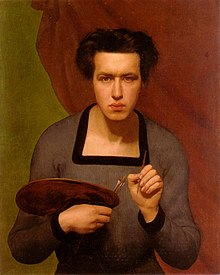Louis Janmot
Anne-François-Louis Janmot (21 May 1814 – 1 June 1892) was a French painter and poet.
Early years
Janmot was born in
After his return to Lyon in 1836, Janmot would attract the attention of critics of the
In 1856, Janmot obtained a commission to paint a fresco (since destroyed) representing the Last Supper for the church of St. Polycarp. Other orders followed, including the decoration of the dome of the Church of St. Francis de Sales and for the town hall that had been renovated by his friend the architect T. Desjardins. He was then appointed professor at the École des Beaux-Arts.
In Paris and Toulon
Janmot moved to Paris in 1861 after having been promised a commission for the Church of St. Augustine, but this project was abandoned three years later. In experiencing significant family and financial problems, Janmot accepted a professorship at the Dominican School of Arcueil. At that time, in his home in Bagneux, he made many portraits of the members of his family (only photographs are currently available).
After the birth of her seventh child in August 1870, his wife died in Bagneux. While the Prussian troops approached and occupied his home, he fled to Algiers with his stepfather and made landscape paintings. He returned in June of the following year in Paris and led a solitary life. His house in Bagneux had been looted. In 1878, he produced a fresco in the chapel of the Franciscans in the Holy Land, but this work was not followed by any further commission.
Faced with family and increasing financial problems, Janmot came to Toulon, and despite some orders (new Portrait of Lacordaire (1878, Museum of Versailles), Rosaire (Saint-Germain-en-Laye, 1880), Martyrdom of St. Christine (Solliès-Pont, 1882), he lived a retired life. He finished the second part of the Poem of the Soul that the patron and former industrial Félix Thiollier was willing to publish.
In 1885, Janmot married a former student, Antoinette Currat, and returned to Lyon. He made charcoal drawings on the theme of the underworld, which can be regarded as a kind of continuation of the Poem of the Soul, including Purgatory (1885) and The End of Time (1888). In 1887 was published in Lyon and Paris a book of more than 500 pages book entitled Opinion of an artist on art that includes articles previously written by Janmot. He died five years later at the age of 78.
Art style

Janmot has been seen as a transitional figure between
Like
Works
Poem of the Soul
His most significant work, a cycle of 18 paintings and 16 drawings, with verse, called The Poem of the Soul, occupied him for 40 years.
First part : the paintings Second part : the drawings 1. Génération divine 19. Solitude 2. Le Passage des âmes 20. L’Infini 3. L’Ange et la mère 21. Rêve de feu 4. Le Printemps 22. Amour 5. Souvenir du ciel 23. Adieu 6. Le Toit paternel 24. Le Doute 7. Le Mauvais Sentier 25. L’Esprit du Mal 8. Cauchemar 26. L’Orgie 9. Le Grain de blé 27. Sans Dieu 10. Première Communion 28. Le Fantôme 11. Virginitas 29. Chute fatale 12. L’Échelle d’or 30. Le Supplice de Mézence 13. Rayons de soleil 31. Les Générations du Mal 14. Sur la Montagne 32. Intercession maternelle 15. Un Soir 33. La Délivrance, ou vision de l’avenir 16. Le Vol de l’âme 34. Sursum Corda 17. L’Idéal 18. Réalité
-
1. Génération divine
-
2. Le Passage des âmes
-
3. L’Ange et la mère
-
4. Le Printemps
-
5. Souvenir du ciel
-
6. Le Toit paternel
-
7. Le Mauvais Sentier
-
8. Cauchemar
-
9. Le Grain de blé
-
10. Première Communion
-
11. Virginitas
-
12. L’Échelle d’or
-
13. Rayons de soleil
-
14. Sur la Montagne
-
15. Un Soir
-
16. Le Vol de l’âme
-
17. L’Idéal
-
18. Réalité
Other works

- Self-portrait (1832), musée des beaux-arts de Lyon
- Le Christ au Jardin des Oliviers (1840), musée des beaux-arts de Lyon
- musée des beaux-arts de Lyon
- L'assomption de la vierge (1845), musée d'art moderne de Saint-Étienne
- Henri Lacordaire(1802-1861), musée national du château de Versailles et de Trianon
- The Torture of Mezentius (1865), musée d'Orsay
Bibliography
- Élisabeth Hardouin-Fugier, Le Poème de l'âme par Louis Janmot, La Taillanderie, Châtillon-sur-Chalaronne, 2007, (ISBN 978-2-87629-358-8)
- Wolfgang Drost, Élisabeth Hardouin-Fugier, Louis Janmot, précurseur du symbolisme, C. Winter, Heidelberg 1994, (ISBN 3-8253-0209-1)
- Élisabeth Hardouin-Fugier, Louis Janmot, 1814–1892, Presses universitaires de Lyon, Lyon 1981, (ISBN 2-7297-0106-0)
- Louis Janmot, Opinion d’un artiste sur l’art, Vitte & Perrussel, Lyon 1887
- Jane Turner, From Monet to Cézanne: late 19th-century French artists? Grove Art, New York, St Martin's Press, (2000) (ISBN 0-312-22971-2)
- Sylvie Ramond, Gérard Bruyère et Léna Widerkher, Le Temps de la peinture, Lyon 1800-1914, Fage editions, Lyon (2007) 335 p. (ISBN 978-2-84975-101-5)
Notes
References
- Turner, J. (2000). From Monet to Cézanne: late 19th-century French artists. Grove Art. New York: St Martin's Press. ISBN 0-312-22971-2
External links
- Le Poème de l’âme – L'idéal
- Musée des Beaux-Arts de Lyon
- Charcoal sketches online at ArtRenewal Center Museum
- The Poem of the Soul - description of themes of the work
- Rouf, Gabriella (2012). "L'opera di una vita. Louis Janmot e Il poema dell'anima" (PDF). Il Covile. Retrieved 22 February 2013.



















